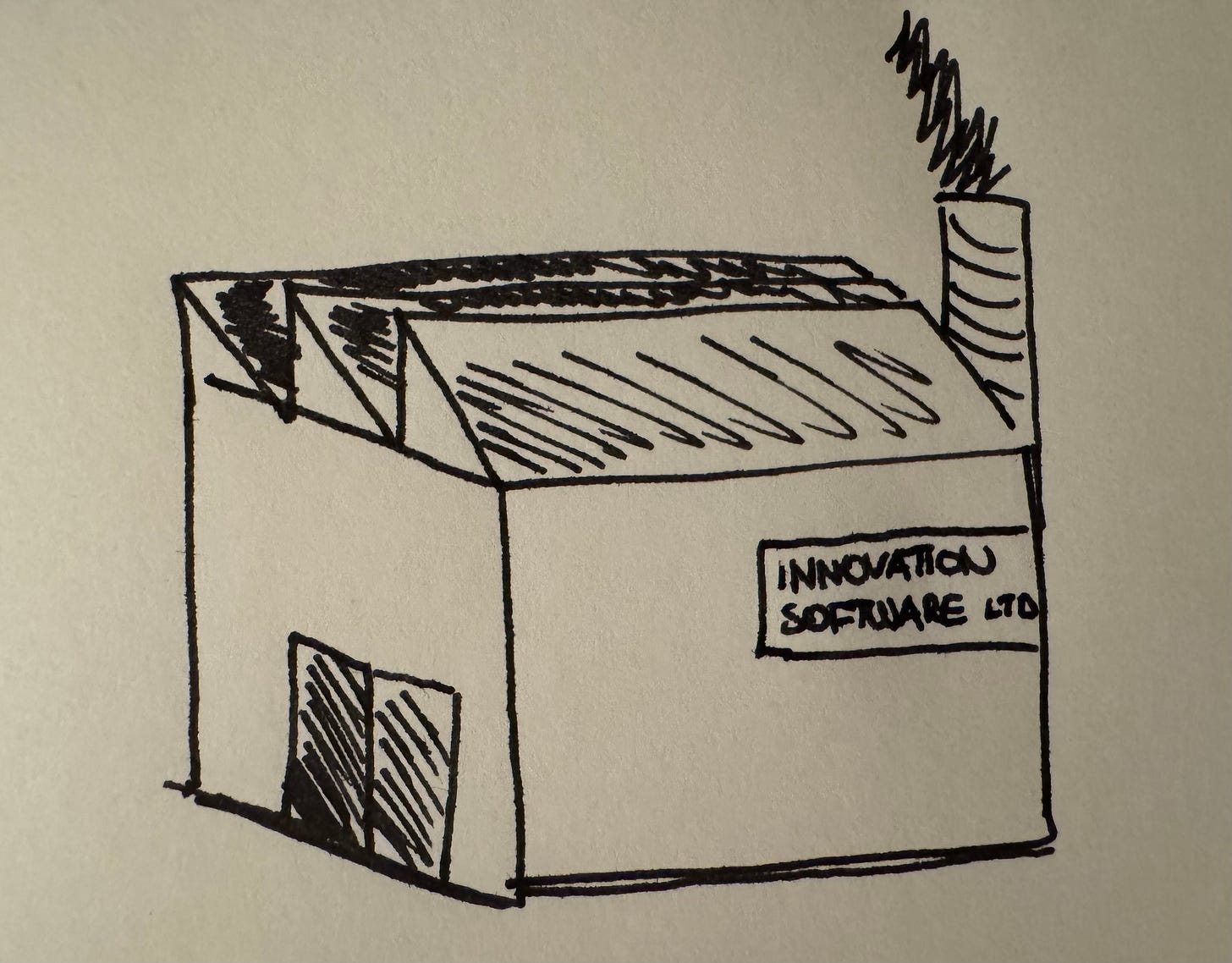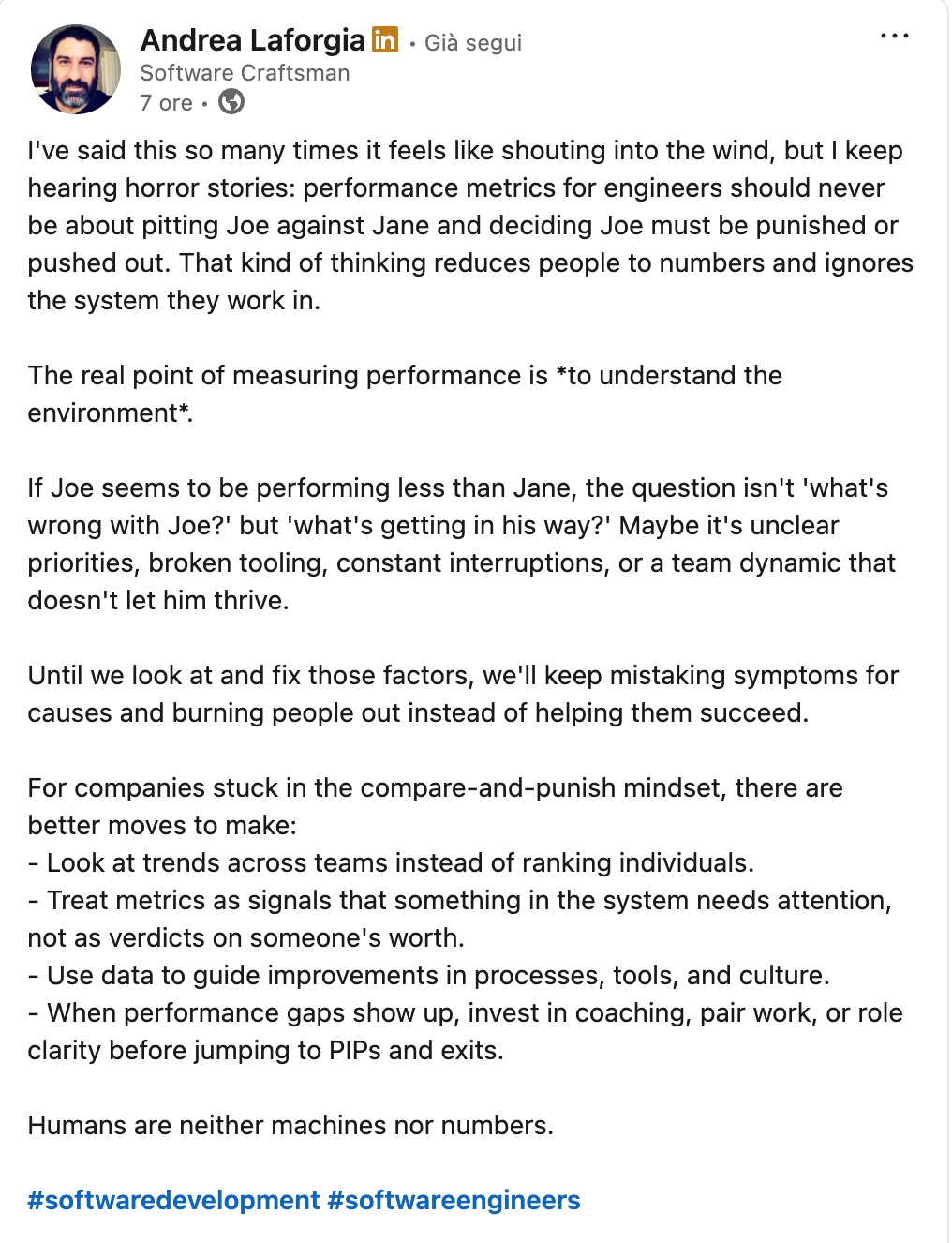Feature factories and the organisational risks
Feature factories are an example of the mechanistic view of software development in which the emphasis on quantity undermines people’s creative skills. They satisfy the needs to maximise productivity and expand a product in a steady and predictable way. Any company that heavily leans on this way of working risks eroding its workforce skills, leaving it unprepared for any challenging times ahead.
Some software developers even enjoy working in one of them. At least for a while. The excitement of building new features and having your impact clearly tied to the amount of code you produce can be addictive. You may end up thinking that’s what software development is all about. Until you fall into the monotony of repetitive work that no longer challenges you. Then boredom comes and with it, frustration.
This aspect is quite known among developers and has been a concern for product managers as well (the term in fact was coined by PM John Cutler). Less attention instead is usually given to the impact on the organisation’s ability to react in times of change, when experimentation and creativity is required to provide differentiating factor to compete in a market that changes fast.
Feature factories usually occur when companies have found product market fit and have gained a solid customer base. At that point, expanding the product is usually necessary to keep the momentum and consolidate the position in the market. The idea behind is that expanding the breath of the existing product is necessary to match or outperform the competition and support the evolving (real or perceived) needs of existing customers. Exploration is usually done inside the existing explored domain space and it builds on top of the existing functionalities.
Delivering in a predictable way allows management to plan the product evolution, often resembling a waterfall approach. To guarantee this, the career path in these organisations tends to incentivise quantity over quality and speed over perfection. The more features you build the easier it is to climb the organisation’s ladder. Showing the impact of your work can often be done by highlighting the quantity of projects you worked on rather than the actual impact of the features. Understanding the value provided is hard and often teams end up sharing only flattering metrics and avoid dig too deep. This is not necessarily done with bad intentions but as a result of imposed focus on new features rather than on evaluation of existing ones.
Questioning the validity or usefulness of functionalities will not help either. Suggesting to limit the efforts to less features is seen an obstacle to “innovation”. I use innovation between quotation marks because the term is used so loosely in the tech sector that it ends up meaning something new but not necessarily original.
When the market signals that something different is needed to satisfy the new emerging needs, feature factories teams start showing the cracks in their foundations. What to build becomes more important and roadmaps become less clear. In this phase many organisations undergo a restructuring to better respond to the new uncertainties of the market. Unfortunately no restructuring can compensate for the time people have spent learning to build fast instead of learning what’s worth building.
During these moments of uncertainty, leadership can start asking for out-of-the-box thinking and creative solutions not realising they have instructed people to do the opposite for so long that most of them no longer remember how to do that. After all, creativity is also a skill that must be trained and refined.
During this critical phase, any reorganisation of teams must be strongly aligned with an extensive work in clarifying the new context in which people will have to operate. Changing the structure is not enough to change people attitude and can create more uncertainty and confusion in the workforce. People need to be inspired, they need to have direction. People need a vision.
Building a vision
Demanding creativity from people requires to be able to build a clear and shared vision that can capture people’s interest and provide a compelling narrative to navigate uncertainty. If it’s true that developers may become complacent in feature factories, the same can be said for leadership and management, who can lose the ability to build visions that truly inspire and unite people.
A compelling vision should be built from the bottom-up and not pushed top-down in order to create real commitment and leverage the knowledge from the people that work more closely with the product and who will build it. This requires more effort than just dictating a strategy from above (you can read more about it here). Often the excuse executives give for this behavior is that lower levels lack the bigger picture or the knowledge to create one. Even though it is often true that leadership have a clearer view of the bigger picture, blaming people on lower levels for lacking skills shows poor leadership and lack of ability to develop companies potential.
With a top-driven approach to build strategies people fall into fake complacency or may actively sabotage the strategy in response to the pressure. It is easy for organisations to blame individuals for not being more proactive and creative. Laziness and lack of skills is usually the first reason management brings up to shift the responsibility on the workforce. Unfortunately most of these organisations have only themselves to blame because with one hand they demand creativity but with the other they still judge people with the same criteria that worked well (to some extent) when running feature factories.
Look at the incentives
One dreadful aspect of this situation is that organisations, driven by the fear of staying behind competition, get more focused on improving performances hoping to beat the market with their execution speed. The obsession with performance is problematic in many contexts but in times of uncertainty this can have devastating effects. It often leads to short-sighted cost cutting moves in order to optimise short term goals. A common problem is the quarterly reporting obsession which affects most publicly traded companies; showing improvements to investors and to the market leads to endangering the company’s ability to survive in the long run.
The focus on performance then leads to strengthening the incentive mechanisms which often translates into focusing on optimising individuals performance. In such model, individuals are ranked against each other supposedly to give them the push to work harder and smarter. But a competitive system like that will work against the end goal to achieve a creative environment. It reduces psychological safety and limits collaboration by instilling a mindset where achieving individual performance improvements is priority over achieving common goals.
In order for ideas to flourish, people need to feel the trust to take risks, challenge decisions and freely share knowledge. Focus on measuring productivity triggers a response on people to game the system so that certain metrics are achieved even if this means working against the actual goals that benefits the organisation as a whole.
Awareness and reflection go a long way
Feature factories emerge from a set of reasons that may disappear or mutate once the market becomes more unstable. Learning to recognise in which phase you are is critical before applying any change. However, the awareness of the effect that feature factories can have on the workforce is already a great step ahead and one I learned to appreciate.
Demanding creativity in a top-down approach is wishful thinking if the context does not offer a fertile ground for ideas to take place. Recognising and admitting that the company itself (read leadership) has a responsibility in the creation of this problem allows to take systemic changes that do not only focus on short term goals but create the proper foundation for an overhaul of the way the company operates.
I wish at this point I had a magic solution to present. One of those frameworks that promise to solve any kind of organisational complexity or that brings clarity through a set of clear steps. I don’t. But I’ve learned to appreciate that even the most obvious insight is worth sharing and maybe this could help whoever is going through a similar situation.
My only recommendation for you is stop building for a moment, put down your imaginary tools, lift your head and look around. There are walls in the box around you that need to be taken down. Only then you will be free from the factory.




